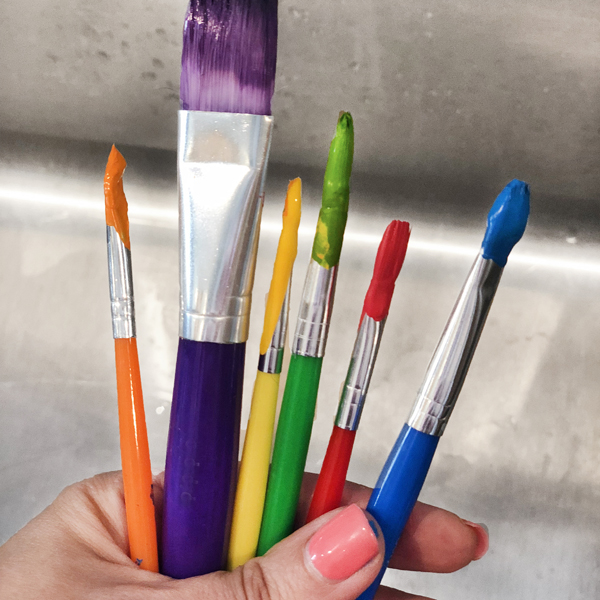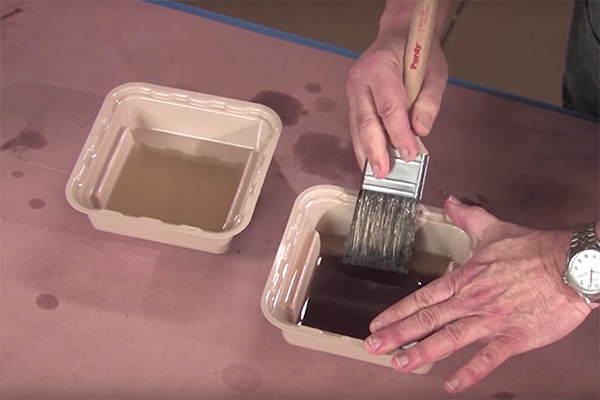To clean a brush after staining, immediately rinse it with mineral spirits for oil-based stains or soapy water for water-based stains. Gently work the solvent through the bristles and then rinse until clear.
Staining projects often leave brushes stiff with dried coating, making them unusable for future tasks. A proper cleaning routine not only preserves the life of your brushes but also ensures your next staining job starts with the right tools. Effective brush maintenance is key to achieving a smooth, professional finish on all your woodwork.
By choosing the right solvent and applying a thorough cleaning technique, you can extend the lifespan of your brushes significantly. Remember that the method of cleaning will vary depending on the stain used – oil-based stains demand a different approach compared to water-based stains. Ensuring a meticulous clean-up after every staining job is crucial for any do-it-yourself enthusiast or professional in the trade.
Introduction To Staining And Importance Of Clean Brushes
Staining wood breathes new life into your projects. It enhances the wood’s natural patterns while providing protection. For a successful stain job, clean brushes play a critical role. They ensure smooth application and optimal finish. Without proper cleaning, brushes become stiff and unusable. This section details how to maintain your brushes after staining tasks.
Overview Of Staining Projects
Staining projects vary from small crafts to large decks. Each requires a specific approach and technique. Brushes link your effort to the final look of your finished project. They come in different sizes and shapes, each serving a unique purpose in the staining process.
Benefits Of Maintaining Clean Stain Brushes
Keeping your brushes clean has multiple benefits:
- Enhanced brush longevity: Clean brushes last longer.
- Better stain application: They deliver streak-free finishes.
- Cost-effectiveness: Reusing brushes saves money.
- Environmental responsibility: Less waste is produced.
Consequences Of Neglecting Brush Care
Ignoring brush maintenance leads to issues:
| Consequence | Impact |
|---|---|
| Stiff bristles | Poor stain application |
| Brush degradation | Shortened brush lifespan |
| Additional costs | Frequent brush replacement |
Preparation For Brush Cleaning
Staining projects can transform the look of wood, but they also leave brushes sticky and hard to clean. Proper preparation for brush cleaning not only extends the life of your brushes but also ensures a smoother start for your next project. This guide walks you through the essential steps for getting your brushes back to their best condition.
Identifying The Type Of Stain Used
Knowing the type of stain on your brush is crucial. Oil-based stains need different cleaners than water-based stains. Check the stain’s label for recommended cleaning agents and follow the instructions. This step dictates the materials you’ll gather for cleaning.
Gathering Necessary Cleaning Materials
- For water-based stains: Warm, soapy water often does the trick.
- For oil-based stains: You will need mineral spirits or a paint thinner.
- Gloves and eye protection keep you safe during cleaning.
- Collect a cleaning container, a brush comb, and rags for wiping.
Understanding The Cleaning Area And Ventilation Requirements
Before starting the cleaning process, choose a well-ventilated area to prevent inhaling fumes from solvents. Outdoor spaces or areas with fans are ideal. Lay down newspapers or plastic sheets to protect surfaces from spills. Ensure proper air flow in your chosen cleaning spot.
Step-by-step Brush Cleaning Process
Proper cleaning and maintenance of your brushes after staining not only prolongs their lifespan but also ensures that your next project starts with the right tools in the best condition. Follow this simple, step-by-step brush cleaning process to keep your brushes in top shape.
Removing Excess Stain From The Brush
Begin by wiping off excess stain from your brush onto a piece of scrap wood or paper towel. This reduces the amount of cleaner needed and makes the process more efficient. Use a brush comb to remove more stain and to maintain the bristles.
Selecting The Appropriate Cleaning Solution
Choose a cleaner based on the type of stain used. For oil-based stains, opt for mineral spirits or paint thinner. Water-based stains require just warm, soapy water. Pick the right solution for effective cleaning results.
The Cleaning Procedure For Oil-based Stains
- Dip the brush into a container with mineral spirits or paint thinner.
- Gently work the solvent into the bristles to dissolve remaining stain.
- Press the brush against the container’s sides to squeeze out the liquid.
- Repeat the process with fresh solvent until the liquid stays clear.
The Cleaning Procedure For Water-based Stains
- Start by soaking the brush in warm soapy water.
- Swirl and press the brush to release the stain.
- Change the water and repeat until it runs clear.
- Use a brush comb for thorough cleaning.
Rinsing And Drying The Brush Properly
For both oil and water-based stains, the final step is rinsing the brush with clean water. Shake off excess water and use a clean towel to gently blot the bristles. Reshape the brush head and leave it to dry horizontally on a flat surface.

Credit: www.blueistyleblog.com
Preservation And Maintenance Of Stain Brushes
Taking care of your stain brushes can save you time and money. Clean, well-maintained brushes perform better and last longer. This guide provides tips on how to store, maintain, and decide between cleaning or replacing your brushes.
Proper Storage Techniques For Brushes
Avoid damage and keep brushes ready for the next project with correct storage. Follow these steps:
- Clean brushes thoroughly after use to remove excess stain.
- Shape the bristles to prevent bending.
- Hang brushes or lay them flat to avoid bristle damage.
Never store brushes on their bristles or in standing water, as this will ruin their shape.
Regular Maintenance Tips For Longevity
Regular maintenance extends brush life. Here are easy tips:
- Avoid soaking wooden handles in liquid to prevent swelling and cracking.
- Use a brush comb to remove dried stain from bristles.
- Rinse brushes in the appropriate solvent according to the stain type.
When To Replace Versus When To Clean
Brush condition dictates when to clean or replace:
| Clean If: | Replace If: |
|---|---|
| Bristles are slightly stiff | Bristles are damaged or falling out |
| Stain residue is recent | Brush shape is permanently deformed |
| You’ve used water-based stains | Wooden handle is cracked or broken |
Regular assessment helps determine the right action and ensures top-notch performance for your staining projects.
Troubleshooting Common Cleaning Challenges
Cleaning a brush after staining can be easy if you know the right techniques. Stains can be stubborn, and brushes can get damaged. We will address these issues so you can keep your brushes in top condition.
Dealing With Dried Stain On Brushes
Dried stain on brushes can seem impossible to remove. Follow these steps to solve this challenge:
- Soak the brush in mineral spirits or paint thinner.
- Gently comb through bristles with a wire brush.
- Rinse under warm water to clear out the remaining stain.
Restoring Brushes With Damaged Bristles
Bristles can get bent or split over time. Here’s how you can restore them:
- Wash the brush thoroughly with brush cleaner.
- Apply a conditioner or brush restorer to the bristles.
- Wrap the bristles in plastic wrap to reshape them.
Environmentally Safe Disposal Of Stain And Cleaning Fluids
Disposing of stain and cleaning fluids properly is crucial for the environment. Ensure safe disposal:
- Check local regulations on hazardous waste.
- Never pour them down the drain or into the soil.
- Use a certified disposal facility.
Best Practices And Expert Tips
Cleaning your brush after staining wood ensures its longevity and effectiveness for future projects. To maintain the quality of your brushes, it’s vital to follow the best cleaning practices immediately after use. This section will provide helpful guidelines and expert recommendations to keep your brushes in tip-top shape.
Brush Material Considerations For Different Stains
Different stains require different cleaning methods, mostly based on the brush material. For oil-based stains, a brush with natural bristles is ideal; these require a solvent like mineral spirits for cleaning. Water-based stains work well with synthetic brushes, which you can clean with soap and water. Remember to check the stain manufacturer’s suggestions.
Eco-friendly Alternatives For Brush Cleaning
For those conscious about the environment, eco-friendly alternatives exist for brush cleaning. Consider using low VOC (volatile organic compound) solvents or solutions like vinegar and baking soda. Always dispose of any cleaning substances responsibly.
Expert Recommendations For Brush Care
Experts agree that proper brush care enhances performance and extends brush life. Here’s a quick guide:
- Wash the brush thoroughly, removing all excess stain.
- Avoid soaking the brush for too long, as it can damage the bristles.
- Shake off any excess liquid and shape the brush before leaving it to dry.
- Store brushes hanging or lying flat once clean and dry.
By adhering to these guidelines, your brushes will remain in perfect condition for your next staining project.

Credit: www.woodworkersjournal.com
Frequently Asked Questions On How To Clean a Brush After Staining
How Do You Clean Paint Brushes After Using Wood Stain?
Clean paint brushes used for wood stain by gently wiping excess stain on a paper towel. Soak brushes in mineral spirits for about 20 minutes, agitate gently, rinse in fresh mineral spirits, then wash with warm, soapy water, rinse, and let dry.
Can You Reuse A Brush After Stain?
Yes, you can reuse a brush after staining. To do so, clean it thoroughly with mineral spirits or a cleaner designed for the specific type of stain, then allow it to dry completely before the next use.
Can You Clean A Stain Brush With Water?
Yes, you can clean a water-based stain brush with warm, soapy water. Gently rinse until the water runs clear. For oil-based stains, use mineral spirits or paint thinner instead of water. Always follow with a thorough water rinse.
How Do You Wash Stain Out Of A Brush?
Rinse the brush under warm water, apply a small amount of mild soap, and gently work out the stain. Rinse thoroughly until the water runs clear and let the brush air dry.
Conclusion
Wrapping up our guide, we’ve tackled stain removal from brushes effectively. Remember, prompt cleansing extends their lifespan. Embrace these tips for optimal brush care, ensuring your next project’s success. Happy staining — and even happier cleaning!
As an Amazon Associate, Cleanestor earns from qualifying purchases at no additional cost to you.